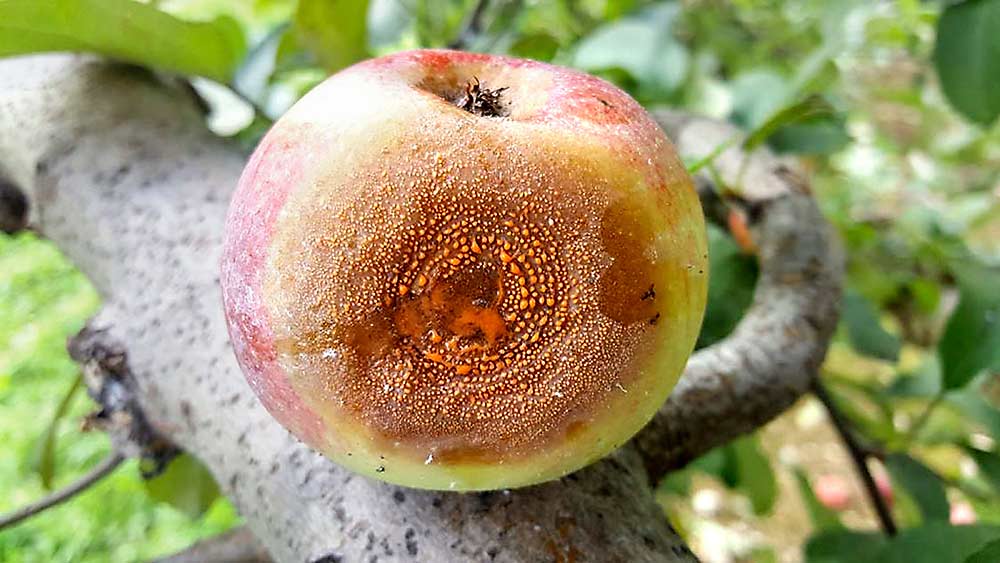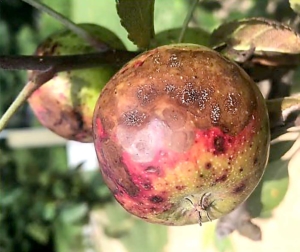
This summer, plant pathologists at Cornell University announced the identification of a new fungal pathogen that causes bitter rot disease in apples. They also found a second fungus known to cause rot in other fruits but never known to affect apples, until now.
The discoveries came as a surprise to Srdjan Acimovic, a senior extension associate at Cornell’s Hudson Valley Research Laboratory and lead researcher of the bitter rot study.
Bitter rot used to be an intermittent problem for New York state’s apple growers. In the past few years, however, more growers, especially in the lower Hudson Valley, have detected more rots in orchards and storages, leading to loss of apples and profits. Outbreaks were particularly bad in 2017 and 2018, not just in New York but throughout the Midwest and New England. Both years saw unprecedented amounts of rain, which disrupted regular crop protection programs, Acimovic said.
With financial help from the New York State Apple Research and Development Program and the New York Farm Viability Institute, Acimovic’s team collected samples of bitter rot-infected apples from New York and other states. They assumed they would find species they already knew about, but once they started gene sequencing, they found something unexpected, he said.
The pathogens the Cornell team uncovered belong to the genus Colletotrichum, which contains 189 species of fungi that cause rot and anthracnose diseases in multiple fruit crops. The dominant species they found in the apples was C. fioriniae, which they had expected, followed by C. chrysophilum, which had previously been found in other fruits but not apples; and finally, the newly discovered species they named C. noveboracense, Acimovic said.
Acimovic and Fatemeh Khodadadi, a postdoctoral researcher in his lab, also worked with Penn State University researchers to examine apples from Pennsylvania orchards.
Phillip Martin, a graduate student with Penn State, said the two species newly identified as apple pathogens, C. chrysophilum and C. noveboracense, also cause bitter rot on apples in Pennsylvania. His research, which also covered parts of Maryland, Delaware, Virginia and Ohio, found the same three species found in New York, plus an additional five. These species are not necessarily new to the region but only recently, through DNA sequencing, were identified as separate species. They’ve probably always been in New York state, too, but were only recently identified there, Martin said.
“We are discovering that there is much higher genetic diversity than previously thought amongst the fungi that cause bitter rot of apple,” Martin said.
Acimovic said it’s possible that changing climate patterns are expanding the range of Colletotrichum species, which is why new species are being discovered in New York — but that topic requires more study.
“My gut feeling is that in the future, we will probably see a rising incidence of problems with bitter rot, based on changing weather patterns,” he said.
Based on what researchers have found so far, differences exist between the species that cause bitter rot, but the differences are not large enough that they must be managed differently at the orchard level. Growers can follow bitter rot management recommendations without needing to know exactly which species is causing the disease in their orchards, Martin said.
“The basis of bitter rot management remains the same as it has for the past several decades: Practice good horticultural management, such as removal of all dead twigs, branch cankers and rotten fruit mummies that could contribute to overwintering spores, and use broad-spectrum fungicides such as mancozeb and captan as the basis for fungicide programs,” Martin said.
Acimovic said the next research steps include: evaluating fungicides in the field, with help from Cornell pathologist Kerik Cox, to see which work most effectively against the new species; whole genome assembly of the new Colletotrichum species from New York, which will give researchers the ability to track mutations; and the search for possible genes in wild apple species that could be bred into cultivars to confer natural resistance to Colletotrichum fungi.
They also need to discover at exactly what point Colletotrichum pathogens infect fruit. It seems to occur more frequently when high temperatures combine with rain. If it rains frequently in June and July, growers must tighten their spray intervals, Acimovic said. •
—by Matt Milkovich







Leave A Comment